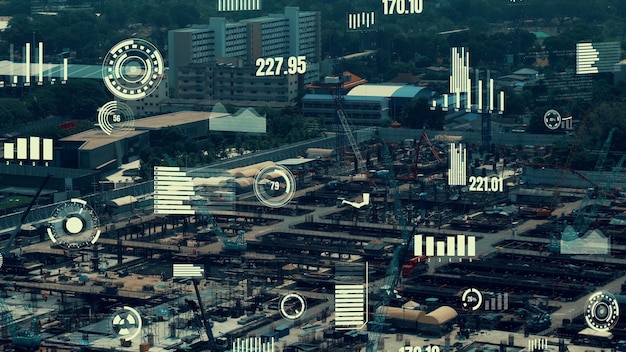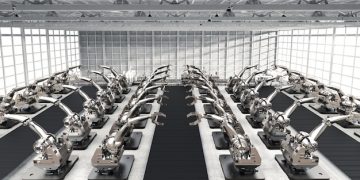Automation’s Impact on US Jobs: Preparing the Workforce of Tomorrow

The Impact of Automation on the US Workforce: Preparing for the Future of Jobs involves understanding how artificial intelligence and robotics are reshaping industries, necessitating proactive strategies for workforce adaptation through retraining, education, and policy adjustments to mitigate potential job displacement and foster economic growth.
The rise of automation is rapidly transforming industries across the United States, raising critical questions about the Impact of Automation on the US Workforce: Preparing for the Future of Jobs. This shift requires a proactive approach to ensure American workers are equipped for the evolving demands of the 21st-century economy.
Understanding the Automation Wave in the US
Automation isn’t a distant threat; it’s a present reality reshaping the American labor market. Understanding the scale and scope of this technological revolution is the first step toward preparing for its impact.
Defining Automation
Automation, in the context of the workforce, refers to the use of technology to perform tasks previously done by humans. This includes a wide range of technologies, from simple robotic arms in manufacturing to sophisticated AI algorithms processing data in finance.
Historical Context
Automation is not new. Throughout history, technological advancements have displaced workers but also created new opportunities. The key difference now is the speed and breadth of automation, driven by advancements in artificial intelligence and machine learning.
- Industrial Revolution: The introduction of machines in manufacturing led to significant job displacement but also created new industries and jobs.
- Computer Age: The rise of computers automated many clerical and administrative tasks, increasing efficiency but also requiring workers to adapt to new skills.
- AI and Robotics: Today’s automation wave, driven by AI and robotics, is impacting a wider range of industries and tasks, including those requiring cognitive skills.
The current wave of automation is unique due to its potential to affect not only manual labor but also white-collar jobs, prompting a need for comprehensive strategies to mitigate negative impacts and capitalize on the opportunities.

Industries Most Affected by Automation
While automation affects nearly every sector, some industries are more vulnerable than others. Understanding which sectors face the most significant disruptions can help target resources and support for workers.
Manufacturing
Manufacturing has long been a pioneer in automation. Robots and automated systems perform tasks such as assembly, welding, and packaging, increasing efficiency and reducing costs.
Transportation
Self-driving vehicles, automated logistics systems, and drone delivery are poised to revolutionize the transportation industry, potentially displacing truck drivers, delivery personnel, and warehouse workers.
Customer Service
Chatbots, AI-powered call centers, and automated customer service platforms are becoming increasingly prevalent, handling routine inquiries and tasks previously performed by human agents.
- Finance: Algorithms and AI automate tasks such as fraud detection, risk assessment, and investment management.
- Healthcare: Robotic surgery, automated diagnostics, and AI-powered drug discovery are transforming healthcare delivery and research.
- Agriculture: Automated tractors, drones for crop monitoring, and robotic harvesting are improving efficiency in agriculture.
By focusing on the industries most vulnerable to automation, policymakers and educators can develop targeted programs to retrain workers and prepare them for new roles in growing sectors, ensuring a smoother transition into the future of work.
The Impact on Different Skill Levels
Automation affects workers at all skill levels, but its impact varies depending on the type of skills required for different jobs. Understanding these nuances is critical for developing effective workforce development strategies.
Low-Skill Jobs
Low-skill jobs involving repetitive tasks are the most easily automated. These include positions in manufacturing, fast food, and data entry.
Mid-Skill Jobs
Mid-skill jobs requiring a combination of technical and interpersonal skills are also at risk. These include positions in customer service, clerical work, and some healthcare roles.
High-Skill Jobs
High-skill jobs requiring creativity, critical thinking, and complex problem-solving are generally less susceptible to automation. However, even these roles are evolving, requiring workers to adapt to new technologies and ways of working.
- Soft Skills: Communication, teamwork, and adaptability are increasingly important as automation takes over routine tasks.
- Technical Skills: Proficiency in data analysis, programming, and AI-related technologies is in high demand.
- Continuous Learning: A commitment to lifelong learning is essential for workers to stay relevant in a rapidly changing job market.
To prepare the workforce for the future, it’s essential to invest in education and training programs that equip workers with the skills necessary to thrive in an automated world, emphasizing both technical expertise and essential soft skills.

Strategies for Preparing the Workforce
Proactive strategies are needed to mitigate the negative impacts of automation and prepare the US workforce for the future. These strategies should focus on education, retraining, and policy adjustments.
Investing in Education
Education plays a crucial role in preparing workers for the demands of an automated economy. This includes promoting STEM education, vocational training, and lifelong learning opportunities.
Retraining Programs
Retraining programs can help workers displaced by automation acquire new skills and transition into growing industries. These programs should be accessible, affordable, and tailored to the needs of local economies.
Policy Adjustments
Government policies can play a critical role in supporting workers during the transition to an automated economy. This includes measures such as unemployment insurance, wage subsidies, and portable benefits.
- Public-Private Partnerships: Collaboration between government, industry, and educational institutions is essential for developing effective workforce development strategies.
- Emphasis on Digital Literacy: Ensuring all workers have basic digital skills is crucial for participating in the modern economy.
- Supporting Entrepreneurship: Encouraging entrepreneurship and small business creation can create new jobs and opportunities.
By implementing comprehensive strategies that focus on education, retraining, and policy adjustments, the US can ensure that its workforce is well-prepared for the challenges and opportunities presented by automation, fostering economic growth and shared prosperity.
The Role of Government and Industry
Government and industry must work together to create a supportive ecosystem for workers adapting to automation. This collaboration should focus on investment, regulation, and innovation.
Government Investment
Government investment in education, research, and infrastructure is crucial for supporting the development and deployment of new technologies and preparing the workforce for the future.
Regulation and Standards
Regulations and standards can help ensure that automation is deployed responsibly and ethically, protecting workers’ rights and promoting fair competition.
Industry Innovation
Industry innovation in workforce development, technology, and business models is essential for creating new jobs and opportunities in an automated economy.
- Data Privacy: Ensuring the ethical use of data in AI and automation is essential for building trust and promoting adoption.
- Job Creation Incentives: Implementing policies that incentivize companies to create new jobs in emerging industries.
- Supporting Small Businesses: Providing resources and support to small businesses to help them adopt new technologies and compete in the global economy.
A coordinated effort between government and industry is crucial for navigating the complexities of automation, ensuring that technological progress benefits all members of society and leads to a more inclusive and prosperous future.
Navigating the Ethical Considerations
Automation raises complex ethical questions about job displacement, bias, and inequality. Addressing these concerns is essential for ensuring that automation benefits all members of society.
Job Displacement
Addressing the potential for job displacement is a critical ethical consideration. This includes providing support for displaced workers and creating new job opportunities in emerging industries.
Bias and Fairness
Ensuring that AI and automation systems are free from bias and operate fairly is essential for promoting equality and preventing discrimination.
Economic Inequality
Addressing the potential for increased economic inequality is a key ethical challenge. This includes implementing policies that promote shared prosperity and ensure that the benefits of automation are widely distributed.
- Transparency and Accountability: Promoting transparency and accountability in the development and deployment of AI and automation systems.
- Worker Rights: Protecting worker rights and ensuring fair labor practices in an automated economy.
- Social Safety Nets: Strengthening social safety nets to provide support for those negatively impacted by automation.
By proactively addressing the ethical considerations surrounding automation, the US can ensure that technological progress leads to a more equitable and just society, fostering a future where all individuals have the opportunity to thrive.
| Key Point | Brief Description |
|---|---|
| 🤖 Automation Impact | Automation reshapes industries, requiring workforce adaptation. |
| 💼 Affected Sectors | Manufacturing, transportation, and customer service face disruption. |
| 📚 Education & Training | Investing in STEM and digital literacy is crucial. |
| ⚖️ Ethical Issues | Addressing job displacement and ensuring fairness. |
FAQ Section
▼
Automation primarily transforms job roles, requiring workers to adapt to new technologies and potentially leading to job displacement in some sectors, while creating opportunities in others.
▼
Industries like manufacturing, transportation, customer service, and finance are highly susceptible to automation due to their reliance on repetitive tasks that can be performed by machines.
▼
US workers should prioritize developing skills in areas such as STEM, digital literacy, critical thinking, creativity, and complex problem-solving to remain competitive in an automated workforce.
▼
The US government can invest in retraining programs, provide unemployment insurance, wage subsidies, and promote public-private partnerships to support workers in navigating the transition to automation.
▼
Ethical considerations include addressing job displacement, ensuring fairness and preventing bias in AI systems, and mitigating the potential for increased economic inequality due to automation.
Conclusion
The Impact of Automation on the US Workforce: Preparing for the Future of Jobs is a multifaceted challenge that requires a comprehensive and proactive approach. By investing in education, retraining, and policy adjustments, fostering collaboration between government and industry, and addressing the ethical considerations surrounding automation, the US can ensure that its workforce is well-prepared for the future, fostering economic growth and shared prosperity for all.





